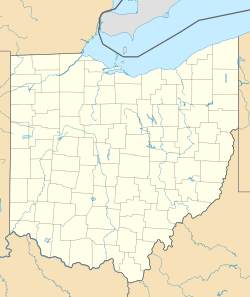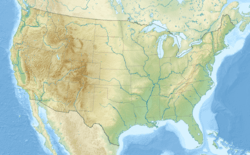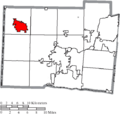Oxford, Ohio facts for kids
Quick facts for kids
Oxford, Ohio
|
|
|---|---|
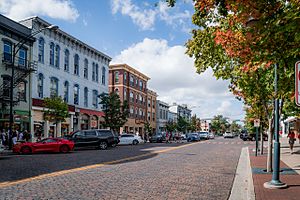
Buildings along High Street in uptown Oxford.
|
|
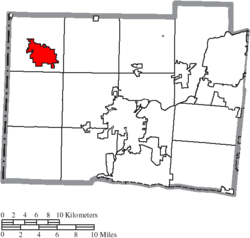
Location of Oxford in Butler County
|
|
| Country | |
| State | |
| County | Butler |
| Chartered | 1809 |
| Platted | 1810 |
| Government | |
| • Type | Council-Manager |
| Area | |
| • Total | 7.78 sq mi (20.15 km2) |
| • Land | 7.78 sq mi (20.14 km2) |
| • Water | 0.00 sq mi (0.01 km2) |
| Elevation | 912 ft (278 m) |
| Population
(2020)
|
|
| • Total | 23,035 |
| • Density | 2,962.70/sq mi (1,143.90/km2) |
| Time zone | UTC-05:00 (EST) |
| • Summer (DST) | UTC-04:00 (EDT) |
| ZIP code |
45056
|
| Area code(s) | 513 |
| FIPS code | 39-59234 |
| GNIS feature ID | 2396116 |
Oxford is a city in Butler County, Ohio, United States. In 2020, about 23,035 people lived there. Oxford is known as a college town because it was founded to be the home of Miami University.
The city is located in southwestern Ohio. It is about 30 miles (48 km) northwest of Cincinnati. Oxford is also part of the larger Cincinnati metropolitan area.
Contents
History of Oxford, Ohio
Miami University was officially started in 1809. The city of Oxford was then planned out on March 29, 1810. This was done by James Heaton, following an order from the Ohio General Assembly.
The city was named after Oxford in England. The first village had 128 lots and became an official town on February 23, 1830. Oxford became a full city in 1971.
A very important event called Freedom Summer began in Oxford in June 1964. This event helped people learn about civil rights. It started with training sessions at Western College for Women, which is now part of Miami University. There is a special memorial near the Kumler Chapel to remember this event.
In 1996, Oxford was recognized as a Tree City USA. This means it takes good care of its trees and green spaces.
Geography and Location
Oxford is located in Oxford Township. This area was originally called the College Township.
According to the United States Census Bureau, the city covers a total area of about 6.68 square miles (17.30 square kilometers). All of this area is land.
Population and People
Oxford's Population Over Time
| Historical population | |||
|---|---|---|---|
| Census | Pop. | %± | |
| 1820 | 258 | — | |
| 1830 | 737 | 185.7% | |
| 1850 | 1,111 | — | |
| 1860 | 1,839 | 65.5% | |
| 1870 | 1,738 | −5.5% | |
| 1880 | 1,743 | 0.3% | |
| 1890 | 1,922 | 10.3% | |
| 1900 | 2,009 | 4.5% | |
| 1910 | 2,017 | 0.4% | |
| 1920 | 2,146 | 6.4% | |
| 1930 | 2,588 | 20.6% | |
| 1940 | 2,756 | 6.5% | |
| 1950 | 6,944 | 152.0% | |
| 1960 | 7,828 | 12.7% | |
| 1970 | 15,868 | 102.7% | |
| 1980 | 17,655 | 11.3% | |
| 1990 | 19,013 | 7.7% | |
| 2000 | 21,943 | 15.4% | |
| 2010 | 21,371 | −2.6% | |
| 2020 | 23,035 | 7.8% | |
| Sources: | |||
In 2020, the city of Oxford had a population of 23,035 people. The median age in the city in 2010 was 21.4 years. This is because many college students live in Oxford.
Arts and Culture in Oxford
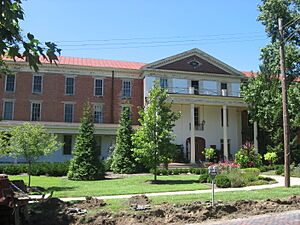

Oxford offers many fun activities and cultural events.
Festivals and Performances
- Oxtoberfest: A local festival.
- Miami University Events: The university hosts many lectures and live performances.
- Uptown Music Concerts: These outdoor concerts happen for four months each year.
- Oxford Wine Festival: An annual summer festival.
Oxford Community Arts Center
The Oxford Community Arts Center (OCAC) is a place for performing arts. It hosts events like the Chocolate Meltdown in January. The OCAC building has a long history. It was first the Oxford Female Institute in 1849. Later, it became the Oxford College for Women. Miami University bought the building in 1928. Today, it is also used for large events like weddings.
Libraries and Museums
Oxford has a public library, which is part of the Lane Libraries system.
There are also several museums to explore:
- Robert A. Hefner Museum of Natural History
- Karl E. Limper Geology Museum
- William Holmes McGuffey Museum
- Richard and Carole Cocks Art Museum
Parks and Outdoor Recreation
The Miami University Natural Areas offer over 17 miles (27 km) of hiking trails. You can hike through places like the Silvoor Biology Sanctuary. You can also explore the 100-acre Western Woods. This area has beautiful oak, beech, and maple trees.
Education in Oxford
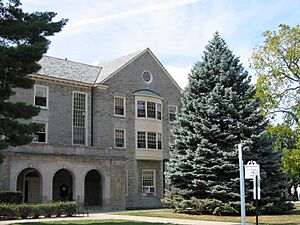
Oxford is well-known for its educational institutions.
Higher Education
Miami University is a large public research university. It has about 20,000 students. Oxford was founded around this university, and it is the biggest college in the city.
The Western College for Women operated from 1853 to 1974. It started as a seminary and later became a liberal arts college. It eventually joined with Miami University. The Oxford College for Women was founded in 1849. It became a dormitory for Miami University in 1928. Now, it is the Oxford Community Arts Center.
Local Schools
The Talawanda School District serves Oxford. It is the public school district for the area. The McGuffey Montessori School offers classes for students from pre-kindergarten to 8th grade.
Transportation
The Butler County Regional Transit Authority provides bus service in Oxford. These buses connect to nearby cities like Hamilton and Middletown. You can also transfer to other bus services that go to the greater Cincinnati area.
Famous People from Oxford
Many notable people have connections to Oxford:
- Walter Alston: A famous Major League Baseball manager. He is in the National Baseball Hall of Fame.
- Weeb Ewbank: A successful football coach who won three World Championships. He is in the Pro Football Hall of Fame.
- Caroline Harrison: The wife of President Benjamin Harrison.
- William Holmes McGuffey: A well-known educator.
- Lorenzo Lorraine Langstroth: Known as the "Father of American Beekeeping."
Sister Cities
Oxford has special connections with other cities around the world:
- Differdange, Luxembourg: This city is home to the Miami University Dolibois European Center.
- Dubno, Ukraine: Oxford formed a sister city relationship with Dubno in 2023.
Images for kids
See also
 In Spanish: Oxford (Ohio) para niños
In Spanish: Oxford (Ohio) para niños


